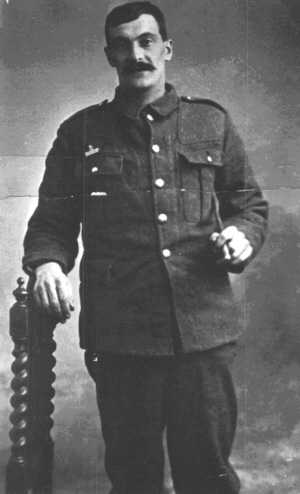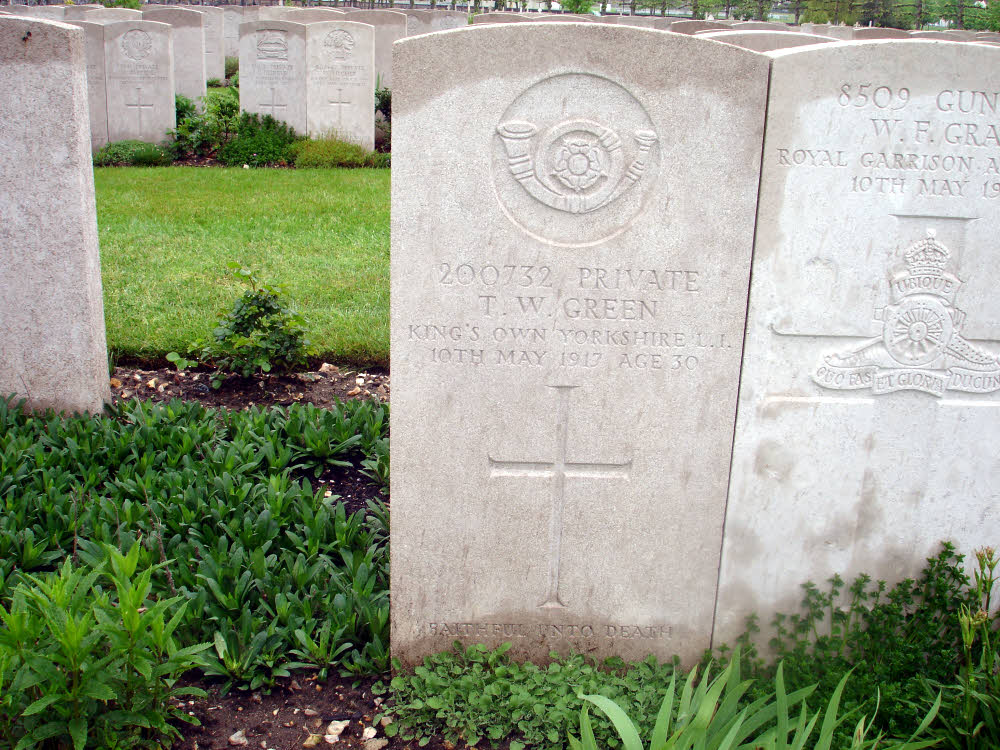
Thomas Willie Green was born on the 6th October 1886 in Lofthouse Gate, Wrenthorpe, Wakefield, the only son of Charles Harry Green (born 1850 in Seaford, Sussex) and Sarah Ann (nee Burton), born 1865, Outwood, Wakefield who were married on the 22nd March 1883 in St. Andrew’s Parish Church Newcastle-upon-Tyne. At the time of their marriage Harry Green was a Royal Artillery gunnery soldier, billeted at the Barracks Soldiers Quarters, St. Andrews in Newcastle upon Tyne. Sarah Ann Burton was living and working at Spital Tongues, a small district now located near Newcastle upon Tyne University at the residence of the Rev. George Brewin, Clergyman.
After their marriage Harry and Sarah Green moved to Dublin, Ireland with Harry’s regiment, presumably before the Irish riots, and their first child, Alice E. Green was born there in 1884. Shortly afterwards, after serving 12 years in the Army, Harry Green was discharged on the 12th June 1884.
Harry and Sarah Green with their new daughter moved back to live in Yorkshire and on the 28th June 1884, he joined the West Yorkshire police force and was posted, in July 1884, to Goole. Their second daughter, Lucy Ann Green, was born on the 23rd April 1885 at Hook, Goole. He was transferred on the 20th November 1885 to the Lower Agbrigg Division based at Calder Grove, Wakefield where he remained until he retired in 1899. Thomas Willie Green was born in 1886 at his grandmother’s house at Lofthouse Gate, Wakefield and a third daughter, Annie Eliza Green was born on the 14th of February 1889, when the Green family were living at Storr’s Hill Rd, Horbury. Harry Green did not live long to enjoy his retirement and he died on the 5th February 1902 from a brain haemorrhage at the age of 51.
Sarah Ann Green married her second husband, 50 year-old widower Lee Summerscales in 1902 at Skegness, Lincolnshire. Lee Summerscales became the new licensee of the Little Bull, South Parade, Ossett in May 1910, but he died on the 14th April 1911 and Sarah Ann Summerscales became the licensee in May 1911.
Thomas Willie Green married Hannah Elizabeth Roper, who was from Horbury, on the 21st April 1906 at the Wesleyan Chapel in Horbury. They had two sons: Harry Green (born 1907) and Sam Roper Green (born 1910). In 1913, the Green family were living in Ossett at 22 Audrey Street and Thomas Willie was working as a miner at nearby Roundwood Colliery.
The KOYLI, 2/4th Battalion was formed at Wakefield on the 30th September 1914 as a second line unit. On the 1st of March 1915 they moved to Bulwell, Nottingham and were attached to the 187th Brigade of the 62nd (2nd West Riding) Division. They moved again in April 1915 to Strensall at York and on then in May to Beverley, going on in November to Gateshead, January 1916 to Larkhill and June 1916 to Flixton Park near Bungay in Sussex. They moved again in October 1916 to Wellingborough and landed at Le Havre on the 15th January 1917.
An obituary appeared in the “Ossett Observer” 1 as follows:
“Ossett Machine Gunner’s Death in Hospital. ‘Always to be depended upon’ – Machine Gunner T. Willie Green.
Official instruction came to hand on Saturday that Machine Gunner T. Willie Green (30) of the KOYLI whom last week was reported to have been admitted into hospital in France suffering from severe shell wounds in the head had died from his injuries. The deceased’s home was 22 Audrey Street, Station Road, Ossett. He leaves a widow and two children. He joined the army soon after the outbreak of the war. A few years ago, he and his wife lived in Horbury. A letter of sympathy received by Mrs. Green from her husband’s sergeant speaks very highly of him and says, ”As number one on the Lewis Gun, he was one of the most reliable men I had in my platoon and will be difficult to replace. I can assure you as his platoon sergeant, I could always depend on him and you have every reason to feel proud for the work he has done out here.”
This also appeared in the BMD column of the “Ossett Observer” a couple of weeks later:
“Died from wounds in the 1st Australian Hospital in France, May 10th 1917, T.W. Green (KOYLI) of 22 Audrey Street, Ossett aged 30 years. Mrs. T.W. Green and family and Mrs. Wilson and family desire to thank everyone for their thoughts.”
Private Green was wounded by shrapnel in the 2nd Battle of Bullecourt on the 3rd of May 1917. His 62nd (West Riding) Division attacked using all three of its brigades, supported by ten tanks of “D” Battalion and with 22nd Brigade of 7th Division in reserve at Mory. The 62nd had until late in I915 been a second-line division, supplying the 49th Division with drafts, and it was not yet the effective formation that it afterwards became. The 187th brigade on the left was to advance to the first objective and then form a defensive flank. It was the division’s first major engagement since arriving in France. Despite heavy fire and close-in fighting, the 2/5th West Yorkshire penetrated through to the northern outskirts of Bullecourt, but reinforcements could not reach them.
On the left, the battalions of 186th and 187th Brigades met with mixed success, with some men getting as far forward as the factory. Three tanks entered the village and others got through the Hindenburg Line NW of it, but were outpaced by the infantry and then found them falling back. Attempts to reinforce the parties that had advanced the furthest proved costly and fruitless, and by noon all, except those at the factory, had been killed or captured.
The 187th Brigade had captured part of the front Hindenburg trench, but was repulsed. Lieutenant-Colonel Watson of 5th King’s Own Yorkshire Light Infantry rallied it, but both he and his adjutant were killed, the second attempt failed, and by an early hour the brigade was driven out of the front line also.
Orders were hurriedly sent to 22nd Brigade to assist, but it was not until 10.30pm that the 2nd HAC and 1st Royal Welsh Fusiliers came into action, and they very soon faced counter attacks. At 4am on 4 May, a heavy German bombardment hit the 2nd Royal Warwickshire and 20th Manchesters while they formed up ready to advance.

Above: Map showing the positions of 62nd (West Riding) Division and the 2/4th KOYLI at the Battle of Bullecourt in May 1917 where Private T. Willie Green was fatally wounded.
Private Thomas W. Green is buried at the St. Sever Cemetery Extension 2, Rouen, France. St Sever Cemetery and St. Sever Cemetery Extension are located within a large communal cemetery situated on the eastern edge of the southern Rouen suburbs of Le Grand Quevilly and Le Petit Quevilly of Rouen. The picture below, courtesy of Reg Unsworth, shows the gravestone in May 2016.

During the First World War, Commonwealth camps and hospitals were stationed on the southern outskirts of Rouen. A base supply depot and the 3rd Echelon of General Headquarters were also established in the city.
Almost all of the hospitals at Rouen remained there for practically the whole of the war. They included eight general, five stationary, one British Red Cross and one labour hospital, and No. 2 Convalescent Depot. A number of the dead from these hospitals were buried in other cemeteries, but the great majority were taken to the city cemetery of St. Sever. In September 1916, it was found necessary to begin an extension, where the last burial took place in April 1920.
The cemetery extension contains 8,348 Commonwealth burials of the First World War. There are also 8 Foreign National burials here.
References:
1. “Ossett Observer”, 19th May 1917